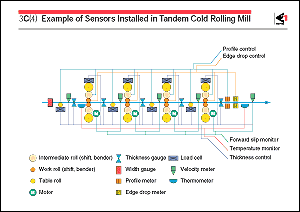The figure shows an example of
the sensors installed in a standard tandem cold rolling mill
and the control functions of these sensors.
A rolling mill for flat products must produce products free from
camber and bends while obtaining the desired thickness and width.
Thickness control is carried out by repeating a process that
involves (i) measuring the strip thickness with a sensor, (ii)
calculating the difference between the measured and target thicknesses,
(iii) converting the difference into the desired roll gap to
compensate for this difference by a static control model, and
(iv) adjusting the screw-down device to this roll gap. In practice,
rolling is started by setting the rolling conditions given by
the model so that the target values are met. During rolling,
additional control is conducted to correct by the sensors and
control units the deviation of measured values from the target
value. This additional control is called dynamic control. Modern
rolling mills are equipped with numerous sensors and control
units, in addition to the basic hardware used to support and
drive the rolls.
Strip thickness is adjusted by controlling the amount of rolling
reduction of the work rolls, using thickness gauges as sensors
installed before and after each roll stand. Control of the profile
by decreasing the strip crown and edge drop is achieved by profile
control units installed in the rolling mill, such as those associated
with bending, shifting, or crossing the intermediate rolls and
work rolls on the basis of the thickness distribution and the
output of the profile detectors.
In tandem mills, rolling is usually conducted with a tensile
force exerted on the material. It is therefore necessary to
maintain the volumetric flow rate of the material constant between
the stands as well as control the tensile force. Failure to
maintain the constancy will result in the strip breaking or looping
between the rolling stands. For this purpose, the rotational
speed of the rolls is controlled based on the results of strip
speed measurement. In recent hot rolling practice, it has become
common to carry out controlled rolling, for achieving required
microstructure by controlling the temperature of the material
being rolled for controlled cooling in accordance with measured
temperatures. |
|
 |
 |
 |
|
|